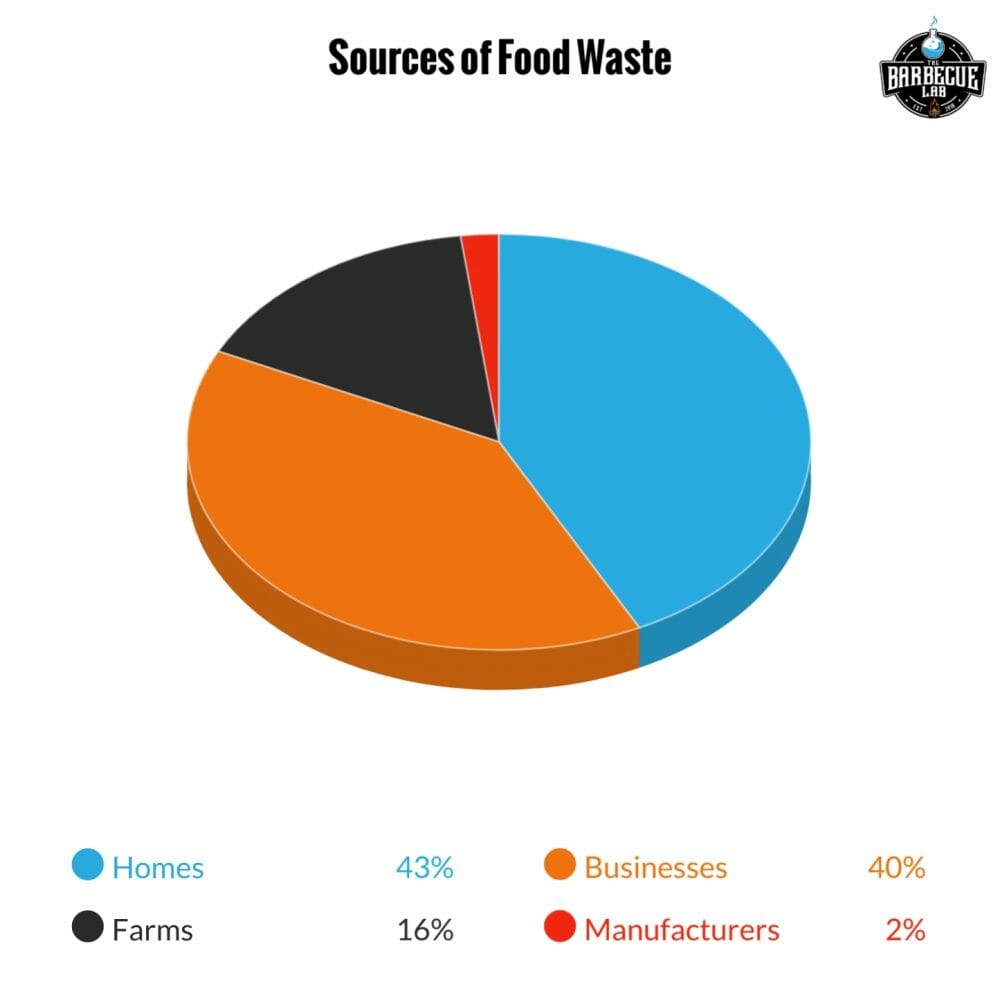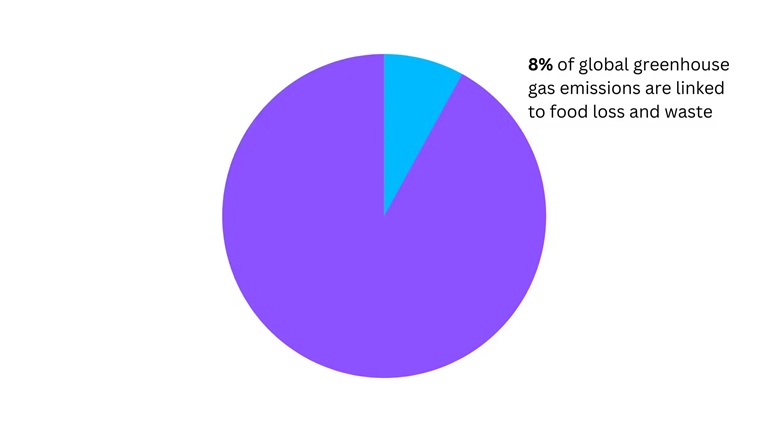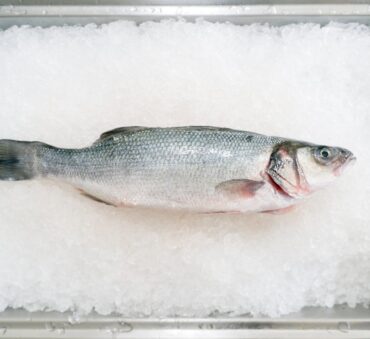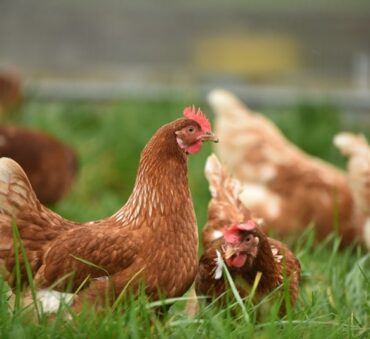Did you know that in the United States alone, up to 40% of all food produced is wasted?
This staggering statistic underscores a grave reality: food waste is a critical issue that demands our immediate attention.
Not only does food waste in the US represent a colossal misuse of resources, but it also has profound environmental, economic, and social implications. From contributing to greenhouse gas emissions to exacerbating food insecurity, the consequences of discarded food resonate on multiple levels.
In this article, we’ll explore the world of food waste, including the current landscape, some surprising food waste facts and statistics, its implications, and the measures we can take to alleviate this problem.
What is Food Waste?
Food waste refers to discarding food that is generally safe for human consumption.
Food Waste vs. Food Loss
Often, food waste is used interchangeably with food loss, but the two are very different from one another. Here is how they differ:
- Food waste: This term refers to the disposal of food that is fit for consumption but is not eaten. It occurs at the retail and consumer levels, driven by factors such as oversupply, cosmetic standards, improper storage, and over-preparation. In restaurants, supermarkets, and households, perfectly edible food is often discarded due to aesthetic reasons, expiration dates, or simply because it has been forgotten.
- Food loss: In contrast, food loss typically happens earlier in the supply chain, from production to distribution. It is the decrease in the quantity or quality of food resulting from inefficiencies in the food supply chain, including poor farming practices, lack of infrastructure, transportation issues, and inadequate storage facilities. This loss is more prevalent in developing countries, where technological and logistical challenges are significant.
The amount of food wasted in the US and globally can be staggering – from surplus farm produce left to rot in the fields to edible items tossed out by consumers.
Next, let’s check out some food waste statistics in America.
Food Waste Statistics & Facts in the US and the World
The issue of food waste is not just a matter of discarded leftovers – it is a profound challenge with global ramifications. Here are some key facts about food waste:
- Roughly a third of the world’s food, about 1.3 billion tons, is wasted annually.
- Globally, 35% of the wasted food is thrown out by supermarkets, shops, and households, often still fit for consumption.
- According to the World Food Programme, all the food produced that ends up as food waste can feed 2 billion people (twice more than the number of undernourished people globally).
- About 80% of Americans discard perfectly edible food due to misunderstanding the expiration labels.
- Every day in the US, about a pound of food is wasted per person.
- The global food system, including food waste, contributes more than a quarter of greenhouse gas emissions, with food waste alone accounting for a carbon footprint of approximately 3.3 billion tons of CO2 equivalents annually.
- Approximately 250 square kilometers (about the area of Athens, Georgia) of fresh water, a quarter of the world’s total, is used yearly to grow food that is never eaten.
- Around 1.4 billion hectares, or 28% of the world’s total agricultural area, is used to produce food that is lost or wasted.
- An area equivalent to the combined size of the US, India, and Egypt is used to grow food that is never consumed.
- The UN estimates the direct economic consequences of global food waste at around $ 750 billion annually.
- The total amount of food waste in the US is estimated to be close to 60 million tons per year, which translates to $165 billion worth of food wasted.
History of Food Waste in the USA
The history of food waste in the United States has been shaped by evolving societal behaviors, technological advancements, and economic conditions.
- Early 20th century: In the early 1900s, food preservation was primarily through traditional methods like canning, smoking, and drying. This era witnessed minimal waste due to the necessity of maximizing food resources. The Great Depression and World War II further reinforced frugal food practices, emphasizing conservation and resourcefulness.
- Mid-20th century advancements: Post-World War II, America saw a boom in technological advancements. Refrigeration became more common, and the rise of supermarkets introduced an abundance of food options. These changes, while increasing food accessibility, also led to a gradual shift in consumption patterns and an increase in food waste.
- Late 20th century consumerism: The latter half of the century marked a significant shift. The advent of fast food, the emphasis on convenience foods, and an increasing distance between food production and consumption contributed to a culture of excess. Junk food waste began to emerge as a societal norm, driven by overproduction and consumer preferences for aesthetically perfect produce.
- 21st century awareness: In recent years, there has been a growing awareness of the environmental and economic impacts of food waste. The staggering data on food waste has spurred movements promoting sustainable food practices, reducing waste at the consumer level, and innovative technologies for food preservation and waste management.
Types of Food Waste
Food waste can be categorized based on various factors, each highlighting different aspects of the waste issue:
By Source
The journey of food waste begins right from the farm and stretches to our kitchen tables.
- Agricultural waste: Did you know some fruits and veggies never make it off the farm? They’re left unharvested or discarded because they don’t meet certain quality standards or due to fluctuating market demands.
- Supermarket waste: In supermarkets, food faces the harsh reality of expiration or damage, leading to significant waste.
- Household waste: Our homes are major contributors to food waste, often through leftovers or groceries that spoil before we can use them.
By Food Type
The type of food wasted also gives us an idea of our consumption habits and preferences.
- Meat waste: Meat waste, including spoiled or unused portions, is a major concern. It’s not just about the waste but also the resources used to produce that meat. For example, did you know that while it takes 2-3 calories of fossil fuel to create 1 calorie of soy protein, it takes 54 calories to produce the same amount of protein from meat?
- Dairy waste: Ever poured out sour milk? Often, dairy products end up in the waste bin because they’re sensitive to processing and storage conditions.
- Bakery waste: Bakeries regularly deal with unsold or stale items like bread and pastries, contributing significantly to food waste.
Organic vs. Inorganic Waste
Food waste isn’t just about the food itself – it’s also about what comes with it.
- Organic: This category includes the actual food that we throw away.
- Inorganic: Think about the packaging – plastic wraps, cartons, and boxes – that come with our food. This non-edible waste also plays a big part in the overall waste problem.
By State of the Food Waste
The condition of the food when it’s wasted can tell us a lot about why it’s being wasted.
- Food byproducts: Consider the peels, husks, and cores – all these byproducts are often overlooked yet significant.
- Expired products: We’ve all hesitated in front of a ‘best before’ label. But do these dates always signal the end of edible life? Usually, this label signifies when the food is at its best, but most food items can be safely consumed even after this date.
- Recalled products: Safety and quality issues can lead to food recalls, pulling food off shelves and into the waste stream.
- Leftovers: That extra serving from dinner, often forgotten in the back of the fridge, adds to the waste tally.
Sources of Food Waste
Food waste occurs at multiple stages in the food supply chain, each contributing significantly to the overall problem:

Agricultural Production
It’s striking to note that globally, 30-40% of food produced by farmers is never consumed and ends up as agricultural waste. These inefficiencies also extend to water usage, with 21-33% of water on US farms wasted.
The loss at the farm level is influenced by numerous factors, such as crop type and market demand. Interestingly, in situations where no market exists for a crop, farmers sometimes plow it back into the earth, enhancing soil quality for future harvests rather than sending it to landfills where it would release greenhouse gases.
Processing and Manufacturing
At the manufacturing level, human error, including poor training and lack of standard procedures, accounts for over 10% of food waste.
This waste is exacerbated in the production of allergen-free products, where entire batches are discarded to avoid cross-contamination.
The development of new products also contributes to waste as manufacturers navigate the challenges of aligning product volumes with quality standards.
Distribution and Logistics
The distribution and logistics stage of the food supply chain is another crucial area where significant food waste occurs.
At this stage occur challenges such as:
- Improper storage
- Handling issues
- Transportation inefficiencies
These factors can lead to spoilage and damage, especially for perishable items like fruits, vegetables, dairy, and meat. The complexity of the supply chain, from farm to fork, means that even small inefficiencies can result in substantial food losses.
Restaurants
The statistics surrounding food waste in restaurants are alarming.
Approximately 84.3% of unused food in restaurants ends up in the trash, with only a small fraction being recycled or donated. An average restaurant in the US can produce up to 25,000-75,000 pounds of food waste a year.
Moreover, it’s estimated that 17% of meals served in restaurants are left uneaten, and 55% of these leftovers are perfectly edible.
The result?
Restaurant food waste costs over $162 billion annually in the US alone.
Retail and Supermarkets
Grocery stores contribute substantially to food waste, with about 43 billion pounds of food wasted each year in the US alone. This waste, which includes 2%-5% of all food due to imperfections and improper handling, amounts to about 30% of the trash from these stores.
The financial impact is profound, as supermarkets lose as much as $18.2 billion per year due to food waste.
Consumer Behavior and Household Waste
The largest proportion of food waste (43%) comes from American households. This is often due to the misunderstanding of expiration labels, leading over 80% of Americans to discard consumable food.
With food waste in America valued at nearly $218 billion, the equivalent of 130 billion meals, the scale of the issue is both economically and ethically significant.
Common Causes of Food Waste
Food waste in the US is a complex issue, caused by a variety of factors at each stage of the food supply chain.
Agricultural Production
Here, the interplay of nature and human activity is critical.
Adverse weather conditions, pests, and diseases can decimate crops, while human factors like overproduction and inefficient farming practices add to the waste. Moreover, harvesting issues such as incorrect timing or damage during the process can result in substantial losses.
Processing and Manufacturing
This stage sees inefficiencies like technical glitches and equipment failures, leading to considerable waste.
Strict cosmetic standards for food mean that much of what is processed may never reach the consumer. And let’s not forget human error – simple mistakes in processing or packaging can have significant wasteful consequences.
Distribution and Logistics
The journey of food from farm to fork is fraught with challenges. Transportation issues, such as damage during transit and logistical errors, are common.
Inadequate storage facilities and poor inventory management can cause food to spoil prematurely. Handling errors, including improper loading and unloading practices, further exacerbate the problem.
Retail and Food Services
Retailers and food service providers often struggle with overstocking, which leads to surplus food.
The pursuit of aesthetic perfection means that good food is discarded based on appearance alone. Confusion over food labels, particularly ‘best before’ and ‘use by’ dates, leads to unnecessary disposal, while inaccurate demand forecasting results in excess food that never reaches the consumer.
Consumer Behavior
At the consumer level, factors like over-purchasing, especially under the influence of promotions or bulk sales, contribute significantly to waste.
A preference for perceived freshness often leads to discarding perfectly good food. Additionally, a lack of awareness about proper food storage and a misunderstanding of labels can worsen the issue.
Inefficient meal planning also plays a role, as purchased food is not used effectively.
Social and Cultural Factors
Societal norms and cultural practices can unintentionally encourage overconsumption and waste. For instance, larger portion sizes in restaurants and homes often result in uneaten food.
Economic Factors
The food market is subject to fluctuations in price and availability, which can lead to either a surplus or scarcity. For example, agricultural policies and subsidies may sometimes inadvertently promote overproduction.
Environmental Factors
Climate change is altering crop yields and food production patterns, while natural disasters can cause sudden shortages or spoilage of food.
Policy and Regulation
The absence of supportive policies for reducing food waste, along with regulatory barriers, such as concerns about liability for food donations, hinders progress in waste reduction.
Furthermore, current policies often lack the incentives or frameworks needed to encourage sustainable practices across the food industry. This includes the lack of standardized guidelines for food labeling and expiration dates, which could significantly reduce consumer confusion and subsequent waste.
Technological and Infrastructure Limitations
In many areas, especially developing countries, there’s a lack of access to preservation technology and infrastructure (like cold storage). This means more difficult and inefficient food distribution and storage, which results in more food waste.
Educational and Awareness Gaps
A significant factor is the lack of consumer education about how to store and prepare food to minimize waste. There is also a need for more robust awareness campaigns highlighting the impacts of food waste and potential solutions.
The Impact & Consequences of Food Waste
The implications of food waste extend far beyond the mere act of discarding uneaten food. Here are some of the most major consequences:
Environmental Impact
The environmental ramifications of food waste include:
- Greenhouse gas emissions and resource wastage: The water, land, energy, and labor utilized in producing wasted food are largely misused. In landfills, decomposing food waste contributes to methane emissions, a greenhouse gas with a substantial impact on climate change. Globally, the carbon footprint of food waste is estimated at 3.3 billion tons of CO2 equivalents.
- Biodiversity loss: The land used for growing food that remains uneaten often results in habitat destruction and the disruption of local ecosystems. In turn, this results in biodiversity decline.

Economic Implications
The economic costs of food waste are just as staggering.
- Cost analysis: In the US, the cost of food waste is estimated to be around $ 218 billion annually, encompassing losses at all levels of the food supply chain – from farms to household kitchens.
- Global and local economic impacts: Globally, food waste translates into lost economic opportunities and systemic inefficiencies. Locally, it impacts the budgets of households, businesses, and governments, diverting resources from potentially more productive uses.
Social Consequences
Food waste significantly exacerbates social issues like:
- Food insecurity and inequality: The paradox of substantial food waste coexisting with widespread hunger highlights deep flaws in food distribution and access systems.
- Ethical implications: The ethical aspect of food waste is particularly striking in the context of global hunger. The staggering contrast between abundance and need prompts critical reflection on societal values and consumption patterns, emphasizing the need for more equitable food systems.
How to Reduce Food Waste?
Addressing the food waste crisis requires actions at multiple levels, from individual practices at home to systemic changes in commercial and business environments.
Let’s check out some of the practices you can start adopting right away to reduce the impact of food waste:
Innovative Practices for Reducing Waste at Home
At the individual level, reducing food waste begins in our kitchens. Effective strategies include:
- Meal planning: Planning meals ahead can significantly reduce food waste by ensuring that only necessary items are purchased.
- Proper food storage: Understanding how to store different types of food can prolong shelf life and prevent spoilage.
- Creative reuse of leftovers: Transforming leftovers into new meals not only reduces waste but also adds variety to the dining experience.
Commercial and Business Level Initiatives
Food businesses are increasingly adopting waste-minimizing practices.
- Sustainable practices in the food industry: Restaurants, for instance, are implementing better inventory management systems to avoid overstocking. Supermarkets are sourcing ‘imperfect’ produce that would otherwise be discarded, and many are also embracing the practice of donating unsold yet edible food to charities.
- Corporate responsibility and waste management: Corporations are integrating food waste reduction into their sustainability goals. This includes adopting zero-waste policies and collaborating with waste management services to find innovative solutions for excess food. For example, as a reliable food waste recycling management company, Shapiro partners with businesses to develop efficient and sustainable waste management strategies, aiding in the pursuit of achieving zero waste goals.
Sustainable Uses of Food Waste
One of the most promising trends in food waste management is the conversion of waste into clean energy. decomposition of food waste through anaerobic digestion, for instance, turns organic food waste into biogas, which can be used as a renewable energy source. This technology not only manages waste effectively but also contributes to energy sustainability.
Converting organic food waste into compost is an age-old method that is receiving a modern makeover. Innovations in composting technologies are making the process more efficient and accessible.
Similarly, advancements in food waste recycling technologies are enabling more effective conversion of food waste into valuable resources, reducing the overall impact on landfills.
The Laws & Regulations of Food Waste in the US
The United States has implemented several food waste laws and regulations at the federal, state, and city levels to manage and reduce food waste. These laws impact businesses and individual households differently, aiming to encourage food waste reduction and ensure safe and effective disposal practices. There are several government agencies regulating food waste according to these laws.
- The Bill Emerson Good Samaritan Food Donation Act (1996): This federal law aims to encourage the donation of food to non-profit organizations by protecting donors from liability, except in cases of gross negligence or intentional misconduct. It provides a legal shield for businesses and individuals who want to donate food but are concerned about liability.
- The Federal Food Donation Act of 2008: This legislation specifically targets federal agencies and contractors, urging them to donate excess, wholesome food to eligible non-profit organizations. It’s an effort to bridge the gap between food surplus and the needs of those who are food insecure.
- US Farm Bill: The Farm Bill, reauthorized every five years, often includes provisions related to food waste. These provisions range from funding for composting and food waste reduction programs to supporting food recovery efforts. Each version of the bill reflects the evolving understanding and commitment to tackling food waste issues.
- Resource Conservation and Recovery Act (RCRA): The RCRA is crucial in setting criteria for waste disposal and management, significantly impacting how food waste must be handled, particularly in large quantities. It plays a key role in ensuring that food waste disposal does not adversely affect the environment.
- US Food and Drug Administration (FDA) Regulations: While the FDA’s primary focus is on food safety, its regulations indirectly influence food waste. Guidelines on food handling, storage, and labeling play a part in determining how food waste is managed, particularly in commercial settings.
Conclusion: The Path Ahead in Food Waste Management
Food waste represents a substantial loss of resources and contributes significantly to environmental degradation. It spans various stages of the food supply chain, from agricultural production to consumer habits, and its impact is felt economically and socially.
If you want to handle your food waste responsibly on corporate level, Shapiro is here to help. As a leader in the organic waste management industry, we have extensive expertise and a robust network. With our waste management services, you can align your sustainability efforts with your business goals and contribute to a more waste-conscious world.
Contact us today for more information.
FAQs
Here are the answers to other questions on food waste:
In the United States, nearly 40% of the food supply is wasted annually, equating to about 60 million tons or 120 billion pounds.
Globally, humans waste approximately 2.5 billion tons of food each year.
It is estimated that around 33% of all food produced globally is wasted.
On average, an American citizen wastes about 219 pounds (almost 100 kilograms) of food per year.
Every day, there are approximately 330 million pounds of food waste in America.
Food waste in America has an approximate value of nearly $ 218 billion annually.
Examples include fruits and vegetables that are discarded due to cosmetic imperfections, leftovers from meals, expired grocery items, and unsold food from retailers and restaurants.
Fruits and vegetables are the most commonly wasted foods in the US, often due to spoilage and aesthetic standards.
Food waste is a significant problem due to its environmental impact, contributing to greenhouse gas emissions and resource wastage. It also represents economic loss and ethical concerns, particularly in the context of global hunger and food insecurity.
The states that produce the most food waste typically correlate with larger populations and urban centers. California, Texas, and New York are among the top contributors.
Proper disposal of food waste can be achieved through various methods: Composting, Anaerobic digestion, Donation, Recycling programs, In-home disposals.
Glossary
- Anaerobic Digestion: A process that breaks down organic materials, like food waste, in the absence of oxygen, producing biogas that can be used as a renewable energy source.
- Composting: The process of recycling organic matter, such as food scraps and yard waste, into a valuable fertilizer that can enrich soil.
- Food Recovery: The practice of collecting edible food that would otherwise go to waste from places like restaurants and grocery stores and distributing it to those in need.
- Food Scrap: Small amounts of food leftovers or residues that are typically discarded.
- Upcycling (Food): The process of transforming byproducts or waste materials into new, higher quality products, often in innovative and creative ways
- Zero Waste: A philosophy that encourages the redesign of resource life cycles so that all products are reused, with no trash sent to landfills or incinerators.
- Landfill Diversion: Actions taken to reduce the amount of waste being sent to landfills, typically through recycling, composting, or reuse.
- Sell-By Date: A label on food indicating the last date the product should be sold, after which its freshness is not guaranteed.
- Best Before Date: A suggested date by which a food product should be consumed for best quality, not necessarily a safety indicator.
- Use-By Date: A date marked on perishable food indicating the last day it should be consumed due to safety reasons.
- Food Donation Act: Refers to legislation such as the Bill Emerson Good Samaritan Food Donation Act, which encourages food donation by protecting donors from liability.
- Sustainable Management of Food: Practices that aim to reduce the environmental impact of food production and consumption by managing food use and waste responsibly.
- Resource Conservation and Recovery Act (RCRA): US legislation that provides the framework for proper waste management and the disposal of hazardous and non-hazardous solid waste.
- Post-Consumer Waste: Waste that is generated by the end consumer of a material stream, such as households or businesses.
- Pre-Consumer Waste: Waste generated in manufacturing and production processes, also known as industrial or commercial waste.
- Biodegradable: Describes a substance or object that can be broken down by microorganisms and thus can decompose naturally without harming the environment.
- Carbon Footprint: The total amount of greenhouse gases, including carbon dioxide and methane, that are generated by our actions.
- Circular Economy: An economic system aimed at eliminating waste and the continual use of resources through principles like reuse, repair, refurbishing, and recycling
- Food Chain: The sequence of processes by which food is grown or produced, sold, and eventually consumed.
- Food Loss: Food that gets spilled, spoiled, or otherwise lost, or incurs reduction in quality and value, before it reaches the final consumer
- Food Security: The state of having reliable access to a sufficient quantity of affordable, nutritious food.
- Greenhouse Gas Emissions: Gases that trap heat in the atmosphere, contributing to global warming and climate change.
- Organic Waste: Waste material that comes from living organisms, primarily plants and animals, which is biodegradable.
- Perishable Foods: Foods that have a limited shelf life and are liable to spoil, decay or become unsafe to consume if not kept refrigerated or frozen.
- Food Waste Hierarchy: The classification of waste management strategies according to their desirability in terms of waste minimization.
- Waste Stream: The complete flow of waste from its domestic or industrial source through to recovery, recycling, or final disposal.
- Waste-to-Energy: The process of generating energy in the form of electricity or heat from the primary treatment of waste.
- Expiration Date: The date after which a product, such as food or medicine, is no longer considered safe to use or consume.
- Biodiversity: The variety of plant and animal life in a particular habitat, or in the world as a whole.
- Conservation: The action of conserving something, in particular, preservation, protection, or restoration of the natural environment and wildlife.
Cited Sources
- United States Department of Agriculture. (n.d.). Food waste FAQs.
- United Nations News. (2013, September). Global food losses and food waste.
- World Food Programme.
- CEO North America. (2023). Food waste in America 2023.
- Troitino, C. (2018, April 23). Americans waste about a pound of food a day, USDA study finds.
- Hall, K. D., Guo, J., Dore, M., & Chow, C. C. (2018). The progressive increase of food waste in America and its environmental impact.
- Food and Agriculture Organization of the United Nations. (2014). Food wastage footprint: Full-cost accounting.
- Liu, P., & Ying, T. (2023). 1.4 billion hectares of agricultural land used to produce food that is lost or wasted. ScienceDirect.
- Feeding America. (n.d.). Our work: Reduce food waste.
- Plumer, B. (2012, August 22). How food actually gets wasted in the United States. The Washington Post.
- Gunders, D. (2017). Wasted: How America is losing up to 40 percent of its food from farm to fork to landfill. NRDC.
- Conrad, Z., Niles, M. T., Neher, D. A., Roy, E. D., Tichenor, N. E., & Jahns, L. (2022). Food waste in the United States: A quantitative data review. National Library of Medicine.
- Garfield, L. (2016, May). Solving food waste in America’s restaurants. Business Insider.
- CIRES. (n.d.). Climate resiliency: Food waste article.
- Natural Resources Defense Council. (n.d.). Wasted food: The impact of food waste on our climate, water, land, and more.
- Pearson, B. (2018, November 5). Food waste is the new sales driver: 4 ways Kroger, Walmart are changing shopper thinking. Forbes.
- CEO North America. (2023). Food waste in America 2023.
- United States Environmental Protection Agency. (n.d.). International efforts on waste food recovery.
- Food and Agriculture Organization of the United Nations. (n.d.). Global food losses and food waste.
Baily Ramsey, an accomplished marketing specialist, brings a unique blend of anthropological insight and marketing finesse to the digital landscape. Specializing in educational content creation, she creates content for various industries, with a particular interest in environmental initiatives.



